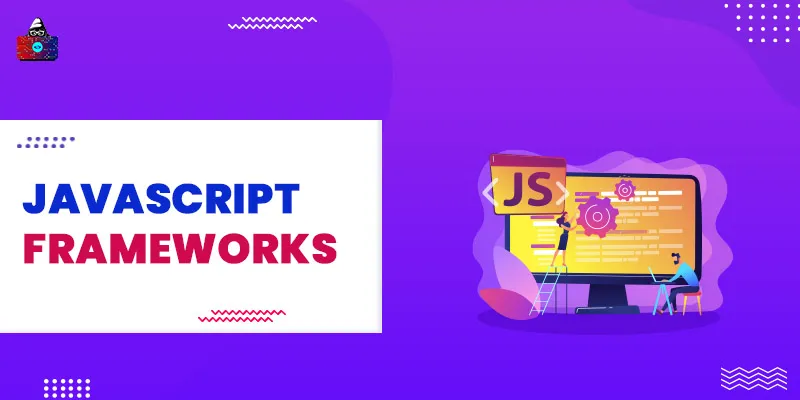JavaScript is one of the most popular programming languages, and its frameworks are just as popular. Developers use JavaScript frameworks to make web applications, and so far, they are doing great. Though JavaScript is used for frontend development and to improve web user interfaces, its frameworks serve the same purpose but in a more productive manner.
In this article, we will discuss some of the most famous front-end JS frameworks so you can pick a suitable one for your future projects, but before that, let's discuss what a JavaScript framework is and why to use it.
What are JavaScript Frameworks?
JavaScript is a web scripting and programming language that is used for front-end web development. Like other programming languages, JS has its own frameworks, and a framework is a software product that contains predefined code and accepts the user-defined code to form a result.
A JavaScript framework makes development easy by saving developers from writing boilerplate code. Also, it has several ready-to-use functions and methods. This is why developers love to use JavaScript frameworks for developing web apps and websites.
Best JavaScript Frameworks
Let's take a quick look at our pick of the top 11 JavaScript frameworks:
- Angular
- React
- Vue.js
- Ember.js
- Meteor.js
- Mithril.js
- Backbone.js
- Aurelia.js
- Polymer
- Webix UI Framework
- JEST Framework
Note : As JavaScript frameworks only accept JavaScript code, so it's better to learn JavaScript first and then learn its frameworks.
1. Angular

Released by Google in September 2016, it is one of the most popular and widely used frameworks of JavaScript. Angular is a powerful and open-source framework having lots of modern features. The frontend framework uses TypeScript, which is a superset of JavaScript. Angular is a complete rewrite of AngularJS, which is also a JavaScript framework. But unlike AngularJS, Angular uses dependency injection, features a CLI tool, and is SEO-friendly.
Important Features
- Angular follows the MVC (Model-View-Controller) architecture, which allows you to separate the business logic from the presentation layer.
- It is a low-code framework.
- It supports two-way data binding.
- This framework comes with a command-line interface called Angular CLI.
- It has a built-in dependency injection.
Pros
- It has a large community and a robust ecosystem.
- Angular supports lazy loading.
- The JavaScript framework comes with a huge repository of open-source packages.
- It is fully customizable.
Cons
- Angular comes with limited SEO options.
- It has a steep learning curve.
- Angular is verbose and complex.
- The frontend framework lacks CLI documentation.
Some Big Companies Using Angular
- PayPal
- Nike
- HBO
- Sony
- Upwork
2. React

React is a JavaScript library, not a framework. Because of its popularity and rich features, it is used as an alternative to the popular JavaScript frameworks to build a solid and interactive front-end user interface. Consequently, it's always a tough call to choose between Angular and React.
Nonetheless, both have their advantages and issues over one another. Developed and maintained by Facebook, React is widely used for the development of mobile applications. React helps to create web pages that are more SEO-friendly, so developers across the world adopt this JS framework for newer projects.
Important Features
- React is composed of reusable components.
- It supports one-way data binding.
- It uses JSX (JavaScript XML) syntax.
- This library makes use of virtual DOM (Document Object Model).
Pros
- React provides high performance due to virtual DOM.
- It comes with a wide variety of extensions.
- JSX syntax allows you to write conditional statements.
- It is simple and easy to use.
- The JS library is SEO-friendly.
Cons
- It has poor documentation.
- React has a continuously changing environment.
- It covers only the view part of an application.
Some Big Companies Using React
- Netflix
- Yahoo Mail
- Khan Academy
- Dropbox
- New York Times
3. Vue.js
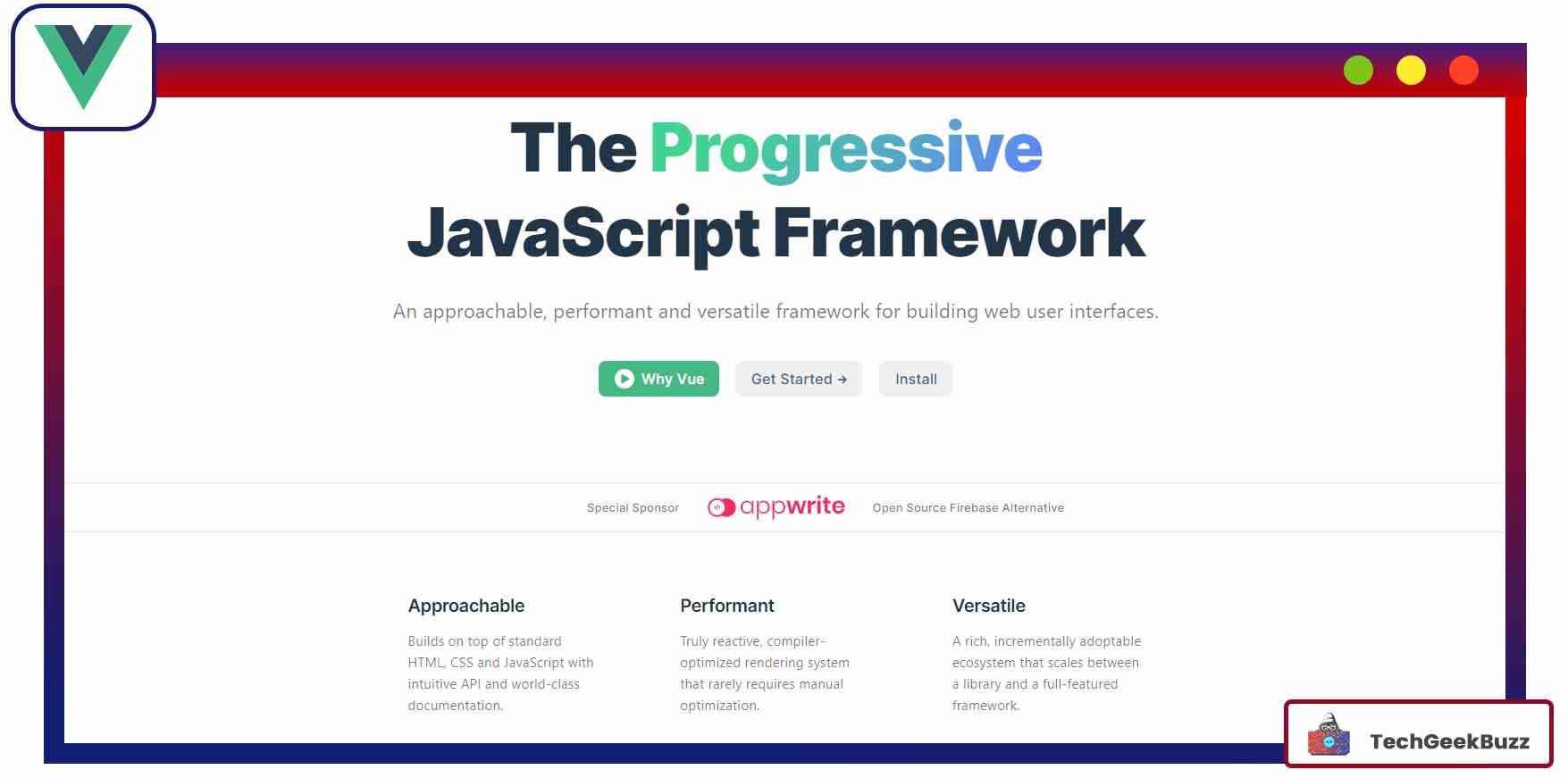
Vue is an open-source JavaScript framework that was released in February 2014. Evan You, a former Google employee, developed Vue with the vision of developing a lightweight JavaScript framework that can be an ideal replacement for Angular.
The JS framework was made under the consideration of HTML-based template syntax. The simplicity and lightweight build of this framework are its main attractions. VueJS is mainly used for developing user interfaces and single-page applications.
Important Features
- Vue.js uses virtual DOM.
- It supports data binding.
- The JavaScript framework comes with components that help you create custom elements.
- It provides HTML-based templates.
- It has built-in directives.
- Vue-router helps you navigate through web pages.
Pros
- It supports applying transition or animation to HTML elements .
- It is a lightweight JS framework.
- The frontend framework is simple and easy to learn.
- It has exhaustive and excellent documentation.
Cons
- The JS framework lacks scalability.
- There is no availability of plugins.
- It does not support large-scale projects.
Some Big Companies Using VueJS
- Alibaba
- Xiaomi
- Adobe
- GitLab
- Grammarly
- Euro News
4. Ember.js
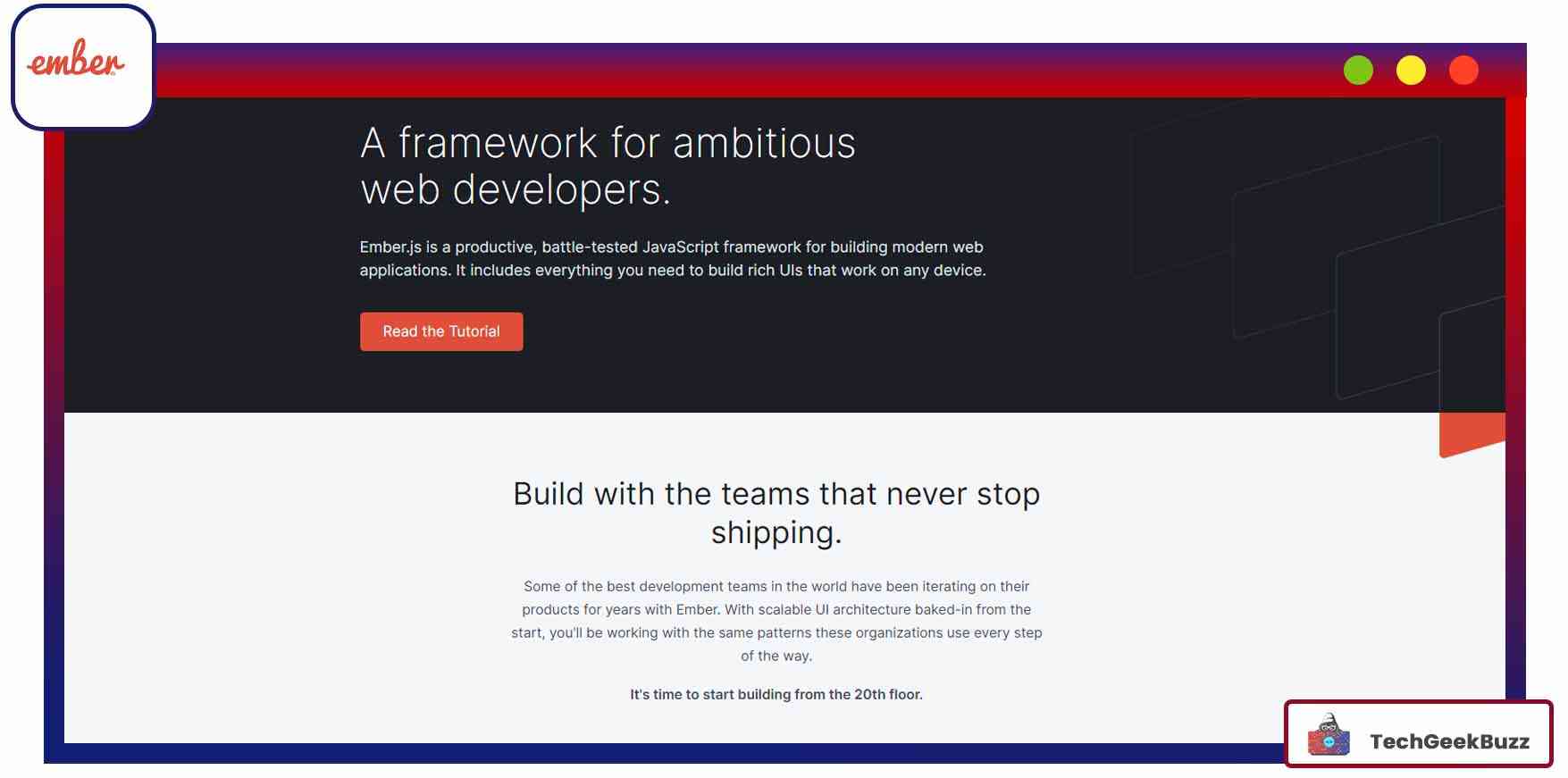
It is an open-source JavaScript web framework that was released in December 2011. Ember is one of the oldest JS frameworks and, thus, has a giant community across the globe. Developed by Yehuda Katz, EmberJS follows the MVVM (Model-View-ViewModel) architecture. Although Ember is also capable of developing desktop applications, it is used primarily for developing single-page web applications.
Important Features
- Ember supports two-way data binding.
- It comes with a built-in router.
- This framework provides full-stack development options.
- It has its own debugging tool called Ember Inspector.
Pros
- The frontend framework offers easy configuration.
- It enjoys active community support.
- The JS framework delivers high performance and faster development with Ember CLI.
- It has excellent documentation.
Cons
- It has a steep learning curve.
- It is a rigid and heavy framework.
- Ember is not ideal for small projects.
- You can't reuse components while working with this framework.
Some Big Companies Using EmberJS
- Discourse
- Chipotle
- Live Nation
5. Meteor.js
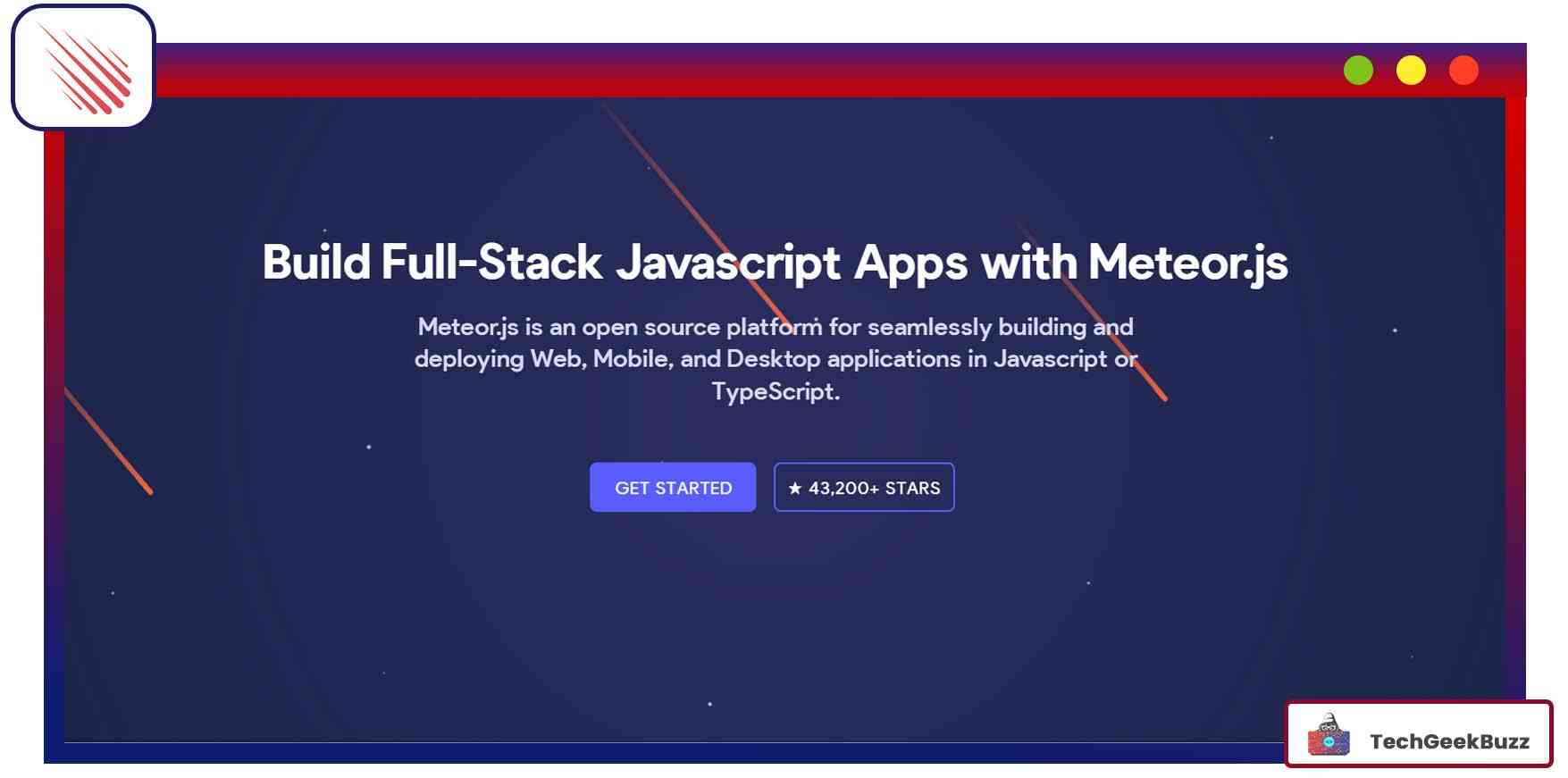
MeteorJS is a JavaScript web framework that was released by Meteor Development Group on 20 th January 2012. It is an open-source JS framework developed using NodeJS. The main feature of this framework is that it can be considered for full-stack development. Unlike other JavaScript frameworks, Meteor can deal with data binding as well as with user interfaces. The full-stack feature of this framework has garnered it plenty of popularity across the developer community.
Important Features
- MeteorJS has built-in reactive templates.
- It comes with a hot code reload.
- The JS framework comes with automatic CSS and JS minification.
- It provides first-in-class front-end reactivity.
- It is an isometric JS web framework.
- Meteor.js supports live reload.
Pros
- It is open-source.
- The frontend framework is beginner-friendly.
- It has active community support.
- Meteor.js is easy to set up.
Cons
- It has a dearth of packages.
- Frequent updates lead to instability.
Some Big Companies Using MeteorJS
- Meteor
- Wild
- Down to Chill
- Weed Web
- Tech Stack
6. Mithril.js
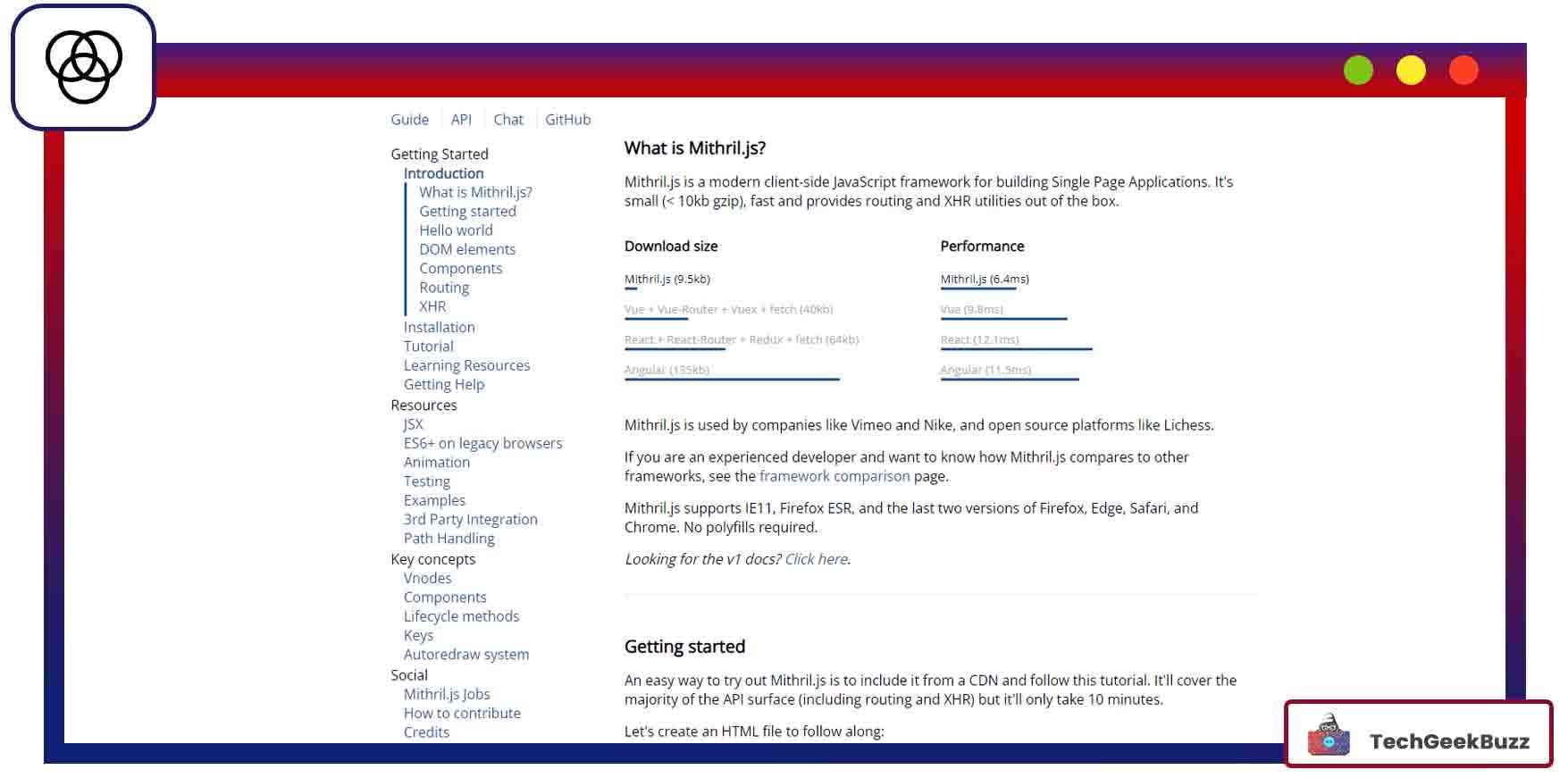
Mithril is an open-source, client-side JavaScript framework. It has a very small storage footprint and comes with minimal documentation to help you figure out its usage. Mithril.js has a file size of less than 8kb (in the gzip format), which makes it faster than other JavaScript frameworks.
Important Features
- Mithril uses virtual DOM.
- It provides flexible routing.
- It follows XHR , which is a way to communicate with the server.
- This framework provides components to create custom elements.
- It has an intelligent auto-redrawing system.
Pros
- It is lightweight and, thus, more performant than other JavaScript frameworks.
- The JS framework has a low learning curve.
- It is compatible with Flux.
Cons
- Small API makes it difficult to work with large and complex projects.
Some Big Companies Using Mithril
- Vimeo
- Nike
7. Backbone.js

Backbone.js is a JavaScript library (and thus, not a JS framework) developed by Jeremy Ashkenas back in October 2010. BackboneJS follows the Model-View-Presenter (MVP) architecture. Though Backbone is one of the oldest JavaScript libraries , it is still widely used by developers for their existing projects and even new ones.
Important Features
- Backbone.js comes with various building blocks, such as models, views, routers, and events.
- It separates the business logic from the presentation layer as it follows the MVC architecture.
- It has a soft dependency with JQuery and a hard dependency with Underscore.js.
- This framework provides JavaScript functions, which makes it easier to develop applications and the frontend.
Pros
- It is free and open-source.
- The web framework acts as the backbone of your project.
- It is fast and lightweight.
Cons
- Debugging may be a painful task.
- The architecture is unclear, as it is an unopinionated library.
8. Aurelia.js
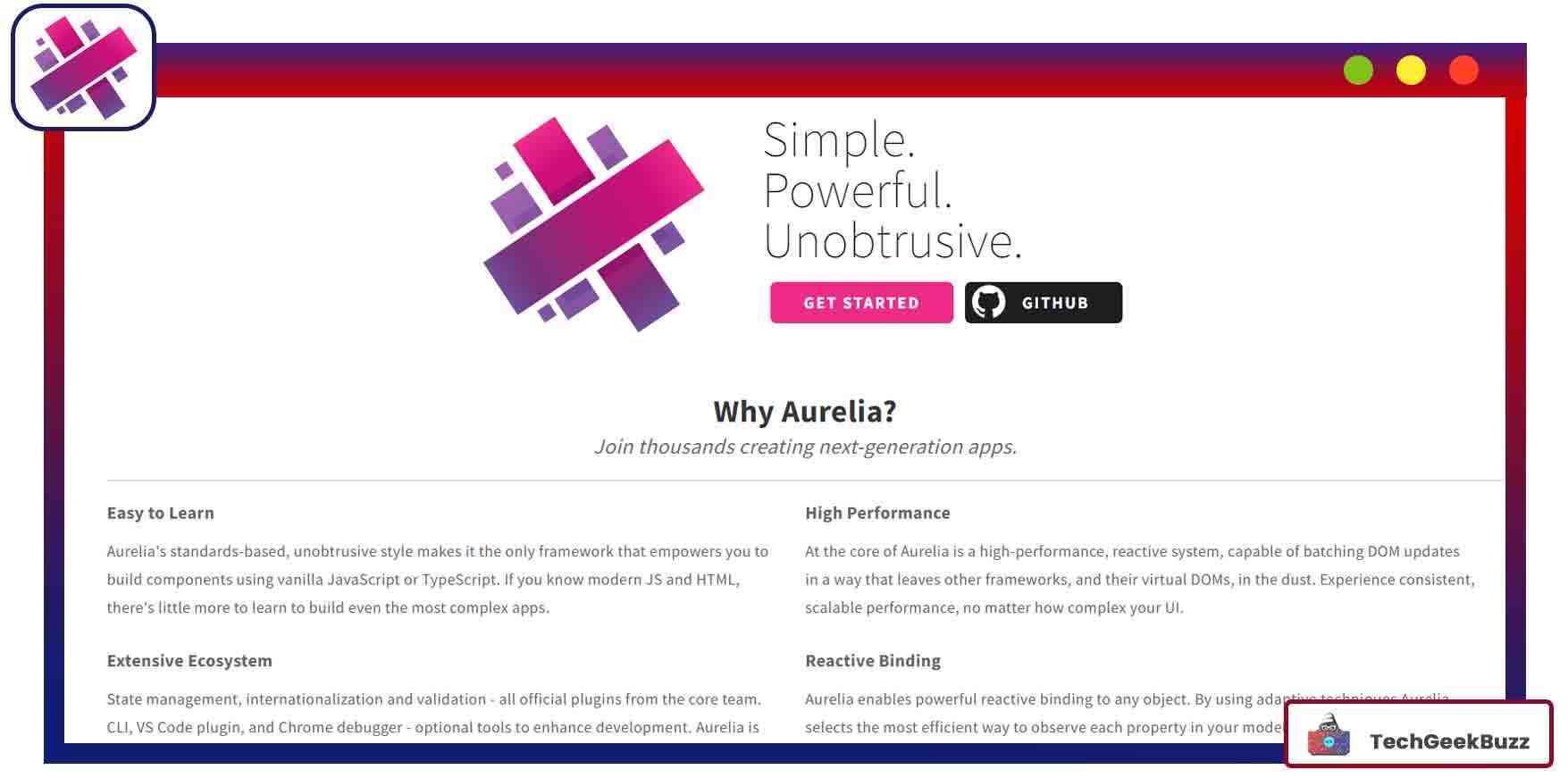
It is an open-source JavaScript framework and also one of the newer JavaScript frameworks. With some new features, Aurelia helps developers to build ultramodern website interfaces. It provides quick services for different conditions and also has a low learning curve. With the help of modern JavaScript on Aurelia, you can develop complex web applications comparatively easily.
Important Features
- It enables reactive binding.
- Aurelia.js offers a wide range of plugins for validation, internationalization, state management, and so on.
- It comes with a robust testing library.
- It has built-in dependency injection.
- Aurelia offers two-way data binding.
Pros
- It is easy to learn.
- It delivers high performance and has a reactive system.
- The web framework is highly extensible.
- Aurelia.js enjoys broad language support.
Cons
- The community support for the JavaScript framework is poor.
9. Polymer
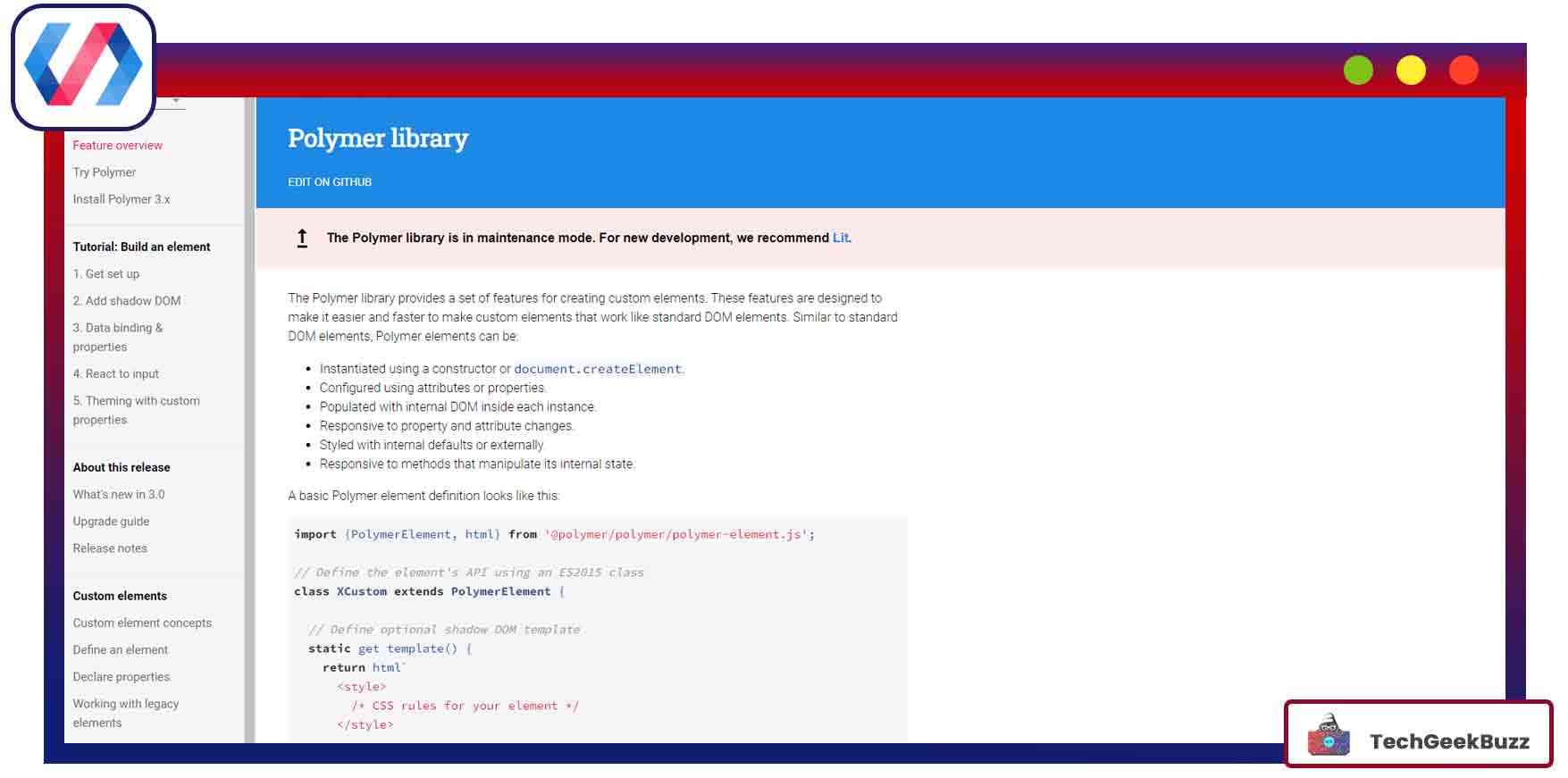
Created by Google and some of its contributors, Polymer is a JavaScript library used to create web applications. Some Google services, such as YouTube, Google Earth, and Play Music, use Polymer. Also, Polymer provides both one-way and two-way forms of data binding.
Important Features
- Polymer supports one-way and two-way data binding.
- It comes with a command-line interface (CLI).
- This JavaScript library leverages Google Material Design.
- It distributes custom elements across the network.
Pros
- It is a cross-browser-compatible library.
- Polymer supports fast and easy mobile application development.
- It allows you to create reusable widgets.
- Polymer is open-source.
Cons
- Polymer delivers low performance on mobile devices.
Some Big Companies Using Polymer
- McDonald’s
- IBM
- Coca-Cola
10. Webix UI Framework
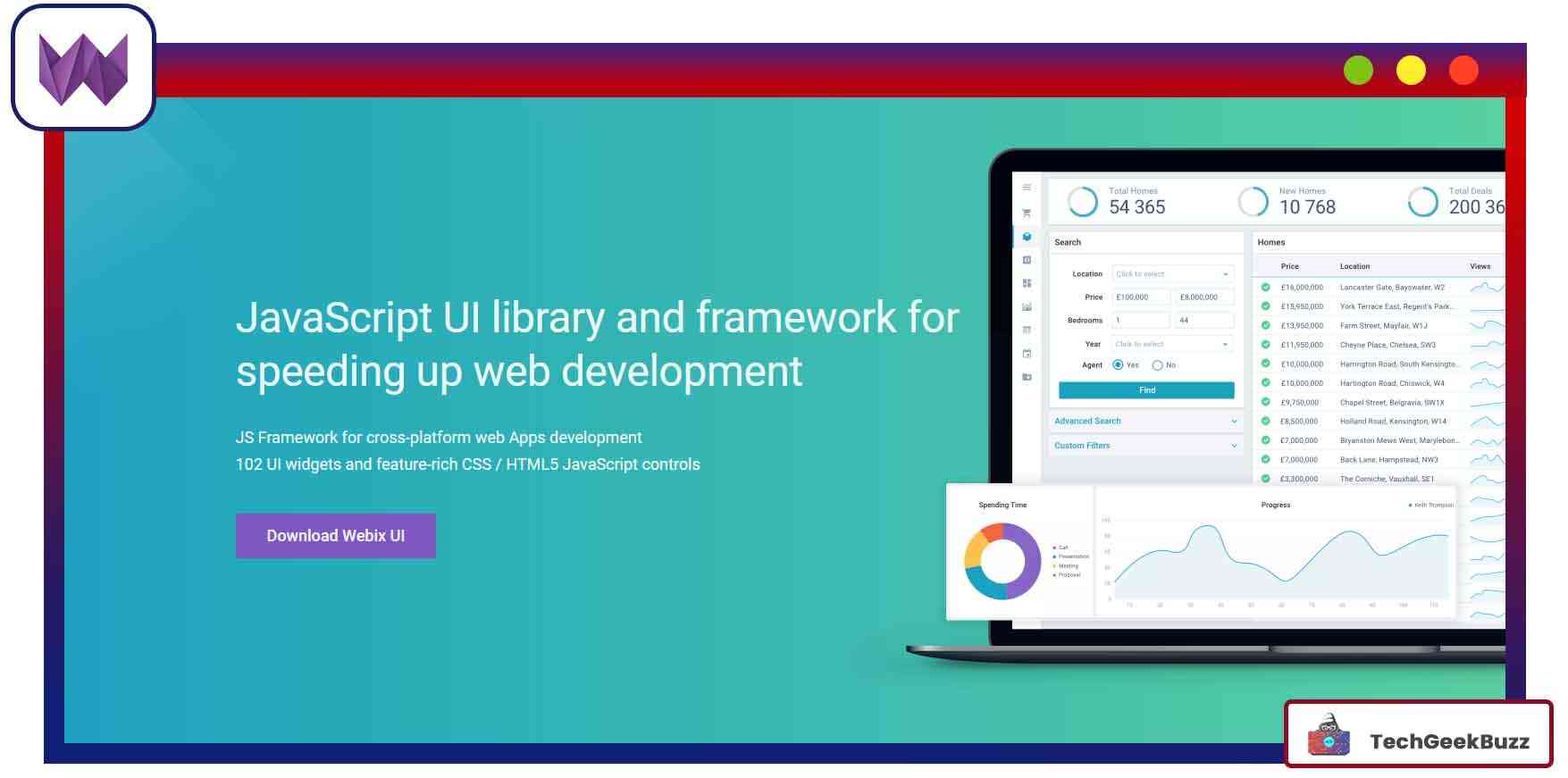
Developed in 2013, Webix is a JavaScript UI framework. The main purpose of Webix is to simplify and speed up the development of the UI layer of any web application. Webix follows the philosophy of "the perfect UI right out of the box, by default and without settings." Thus, Webix does everything possible to make the life of the developers easier. For example, Webix contains predefined content, a set of awesome material skins, and so on.
The creators of this framework took an unusual path. The JS library consists of the Webix core itself, which is a set of more than 100 UI controls and additional complex widgets. The latter are fully functional reactive applications with elaborate logic and a back-end layer.
Important Features
- You can find free online development tools, such as UI Designer, Code Snippet, Form Builder, and so on.
- It uses HTML5 and CSS3 techniques.
- It can easily integrate with other JavaScript frameworks and libraries, including Vue.js, React, and Angular.
- This is a cross-browser-compatible framework.
- It supports dynamic data loading.
- It can integrate with many other third-party tools, such as text editors, charts, and maps.
Pros
- Webix allows developers to build fully-functional mobile-friendly applications.
- It is a lightweight framework.
- It is highly extensible.
Cons
- You may encounter undocumented features sometimes while using the JS framework.
- It lacks documentation.
Some Big Companies Using Webix
- Hilton
- Mazda
- Boston Consulting
- Siemens.com
- Fujitsu
- AT&T
11. JEST Framework
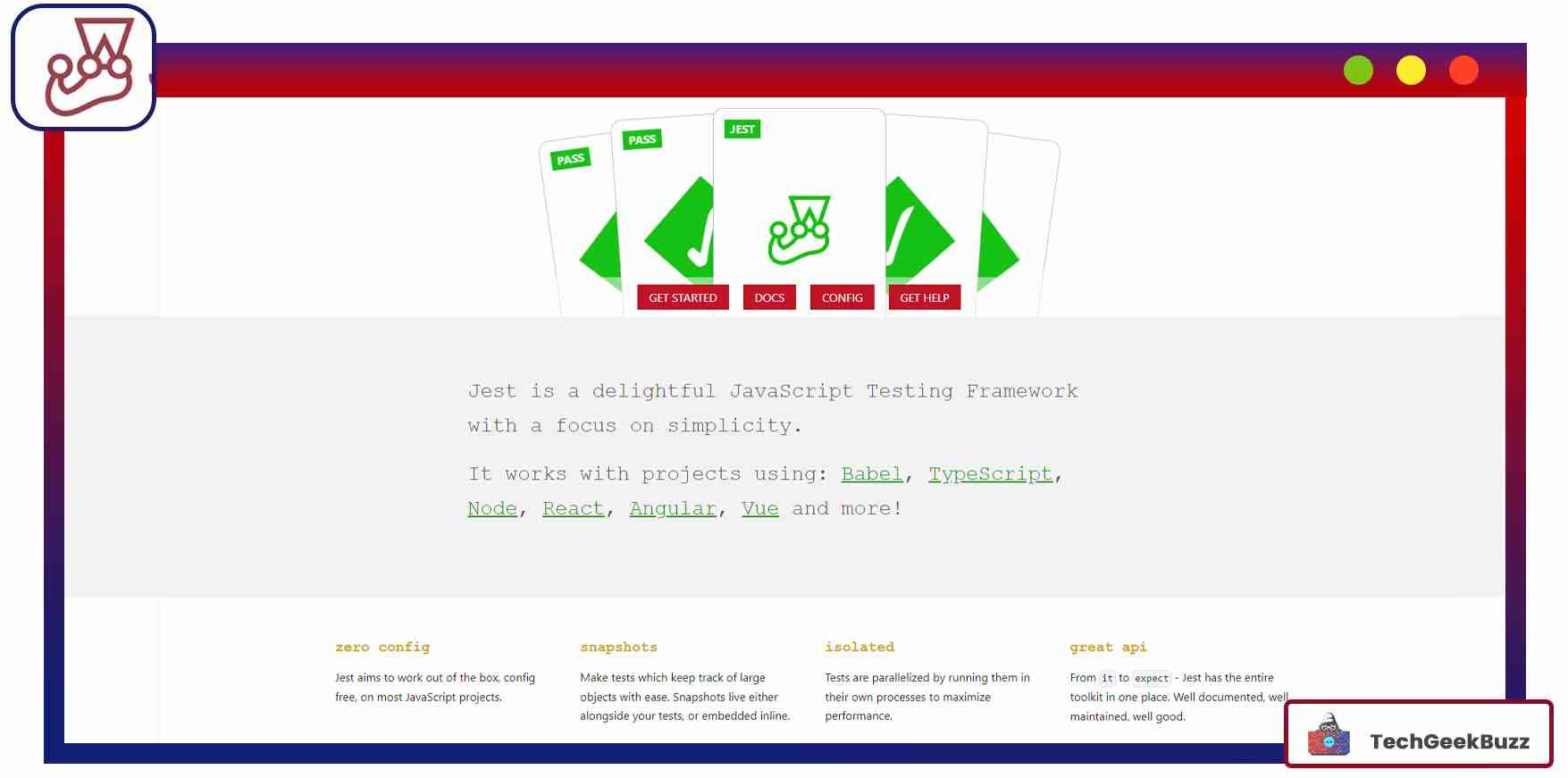
JEST is one of the most popular JavaScript testing frameworks. Developed by Facebook as a " Facebook Open Source Project ," it contains many feature-rich APIs that allow us to write approachable and faster test cases. It does not have many configurations, making it easy to use. The JS framework is highly compatible with the popular automated testing framework "Selenium." With these two powerful frameworks combined, we can perform automated testing on JavaScript code as well as on the complete web app.
Important Features
- With JEST, you can download millions of WordPress themes, plugins, templates, and UI kits.
- It is a one-stop shop with built-in matches, a mocking library, and spies.
- It supports TypeScript.
- JEST has built-in coverage support.
- It does snapshots.
Pros
- JEST is pretty simple to set up.
- It is lightning fast.
- It supports parallel test running.
Cons
- It is slow due to automatic mocking.
- JEST has poor documentation.
Some Big Companies Using JEST
- NewYork Times
- Spotify
- Airbnb
Conclusion
All the JS frameworks that we have mentioned above have their own pros and cons, and it's always a good decision to choose a framework for developing websites and web apps. Also, it's important to choose a framework according to your project demand. So, first, underline all your requirements and then make a suitable pick.
People are also reading:
